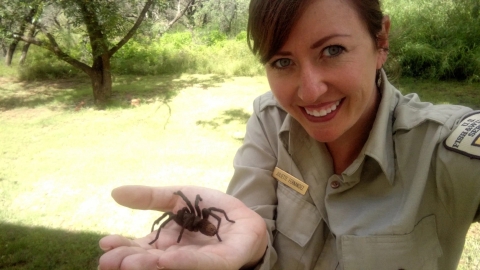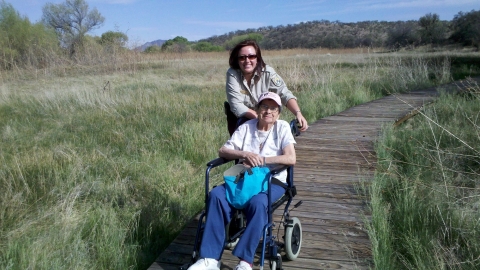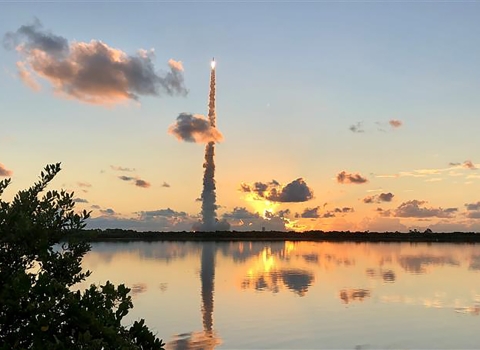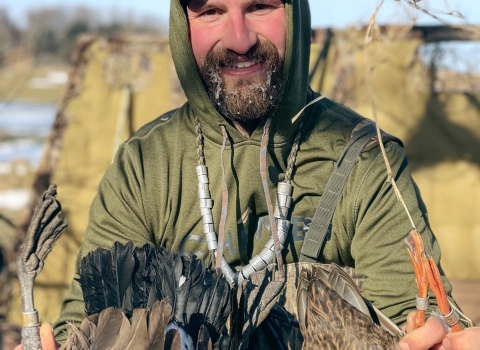Growing up on the international border of Arizona and Mexico, when presidential words of amnesty for immigrants were floated, my school tripled in size. Spanish was the predominant language, Ranchera music played in the grocery stores, and parking lots would cave in from the underground drug tunnels that connected Mexico to outlets in the U.S. I thought this was standard in America.
This is my culture. This is where I come from and why environmental justice is important to me. I would love to learn about you. I am here.
From the Tap
From any high point in my hometown of Nogales, you can see the border fence separating the two countries and the river that flowed from Mexico to the United States, often dry or in a tyrannical flash flood. The border fence changed over the years from a small chain link fence to what now is commonly referred to as “the border wall.” My grandma and great aunt lived in pink and purple adobe houses not far from the shadow of it.
My great aunt and I would walk around, fill the bird feeders, water the plants, and look at bugs. Black clouds from the tire fires in nearby Mexico would float overhead while we were gathering leaves to make tea. We’d take breaks and she would make me my favorite dish of cornmeal, water, and honey, boiled to a soft mush. A few glasses of tap water later, we would walk again. When I would spend the night, we would say our prayers in Spanish before bed to the sound of gunshots ringing out from the Mexican side of the fence. On holidays, many more would ring out, shooting into the sky in celebration. She was my first wildlife refuge, and I was peaceful there.
Healthy Rivers
For many, we found security in nature. A high school teacher taught us about over-population, climate change climate change
Climate change includes both global warming driven by human-induced emissions of greenhouse gases and the resulting large-scale shifts in weather patterns. Though there have been previous periods of climatic change, since the mid-20th century humans have had an unprecedented impact on Earth's climate system and caused change on a global scale.
Learn more about climate change , healthy rivers, and endangered species. Not all were interested, but I was curious. We planted shade trees in the community and he took us electroshocking in the White Mountains of Arizona each summer to save the at-risk Apache trout. None of us assumed a college degree was in the cards, but a job working in nature became my goal.
In the year 2000, the movie Erin Brockovich came out and my sister said we were the “Mexican version” of that movie. She said the water in our town was cancer-laden and high rates of lupus and rare types of cancer were found in those who lived near the arroyo behind my great uncle’s house. At the time, it didn’t register to me. “How strange,” I thought. “My town?”
The Return
Fast forward, I was hired by the Service and eventually moved back to a refuge only 30 minutes from Nogales. I went to the classrooms of the elementary school I attended and told them that my job was possible. I changed the refuge’s annual bluegrass festival to mariachis and Indigenous Mexican dancers. We were on the border after all. I brought the students out to walk the trails, breathe the air, and feel the shade of the trees cooling the path. For many, it was their first outing that far from home.
Eventually, I became the refuge supervisor over Arizona and New Mexico, and moved to Albuquerque, New Mexico, not too different from home. “Environmental justice” became a common duo of words at Valle de Oro National Wildlife Refuge, the urban wildlife refuge in Albuquerque. They were filtering industrial runoff through the refuge before it returned to the river and into the drinking water of the community. The concept surprised me and pulled a heart string, but it didn’t quite register as to why.
A River Parallel
Not long ago, we moved to the Pacific Northwest. As I drove into Washington state, parallel to the vast Columbia River, parasailers wove graciously in every color and waterfalls sprung from the mountain sides. About every fourth car carried a kayak on the roof, dogs wore booties to protect their feet from the heat, and entire families rode their bikes on the sidewalks. This place was so foreign to me with its crisp, clear air and communal outdoor recreation.
“How strange,” I thought. “This new town.”
As a new project leader, I was happy to learn that every staff conversation centered around providing the community equitable access to the green spaces on and off refuge.
I reached out to the Latino organizations in the area to say, “Here is where I came from and why reaching out is important to me. I would love to learn about you. I am here.” Now annually, I present at their leadership conference about my path and how they can do it, too. This year I’m their keynote speaker on climate change and environmental justice. A topic they picked.
We reached out to dementia organizations, Tribal partners, organizations that support people from Black and Brown communities, people with accessibility concerns, refugee support groups, teachers, and young families. Our agenda was only: “Tell us what matters to you. We are here.” The organizations spoke and we are building it.
What’s in a Name?
Words such as “underserved,” “disadvantaged,” and “historically excluded” have quickly become part of the national vernacular. I’ve heard people use the words “environmental justice communities” and reference published articles of what each culture likes or needs. “How strange,” I thought. “There is a playbook for cultures? Are there environmental justice communities?” Categorization felt awkward. I’ve always befriended other living beings as organically as breathing. I’ve done it because my heart ached if I didn’t.
It haunted me a bit and I typed the name of my little border town in the socioeconomic and environmental justice apps that someone had shared with me.
- 99th percentile across the U.S. households where no one over age 14 speaks English well.
- 94th percentile where income is less than or equal to twice the federal poverty level.
- 97th percentile projected risk from wildfire from fire fuels, weather, humans, and fire movement in 30 years.
- 68% high school graduates
- $36,600 median household income
- 47% with full time employment
I remembered my sister’s Erin Brockovich comment and began to read. On both sides of the international border, health impacts were expanding. Air contamination from garbage fires and vehicle emissions from cars waiting to cross the border were causing upper respiratory tract infections, severe asthma, and premature death among elderly people with heart or lung conditions. I read that the river between the two countries was filled with runoff from Mexican factories, including disproportionate levels of E.coli and arsenic, and that the rate of lupus in my town is up to seven times higher than the U.S. average. I learned that the costs to treat lupus can be unattainable for people without the income to afford it. I read that studies were trying to understand the cause of the unusual lupus rates but were yet unsolved, and the community felt at a loss for change without the resources to make it themselves.
I think this is when I had a revelation.
“To the world outside of my town,” I wondered, “were we an environmental justice community? Were we underserved, disadvantaged, and historically excluded? Have we been defined, categorized, and shelved?”
I’ve decided. No. We are not defined by those things. We are not an environmental justice community; we are cornmeal mush, tea leaves, and Spanish prayers. We are people first, vibrant, and humble. We are a community of people facing environmental justice concerns.
In Drought and in Rain
When I think back to Valle de Oro National Wildlife Refuge, cleaning the water with green infrastructure and how it didn’t quite register why it pulled my heart string, I see it clearly now. I see the faces from my hometown in each drop from the tap, in the runoff and the rivers, in drought and in rain.
We, in the Service, can make a change. You can make a change. Through shade trees and filtration through the refuge. Through mentorship and friendship. Through education and support, and not because we need supporters. I implore us to put down the playbook and start with our heart. We can go into our communities and say, “I am here,” and be part of a change that matters to them. We can start with being people first, celebrating all of our cultures. We may come from different languages or spices on our tongues, but we are people first.
I come from a world I didn't know was poisoned because the people were beautiful. Now I understand why healthy land for healthy people matters to me.
This is where I come from and why environmental justice is important to me. I would love to learn about you.
I am here.






